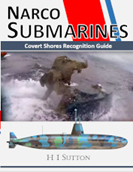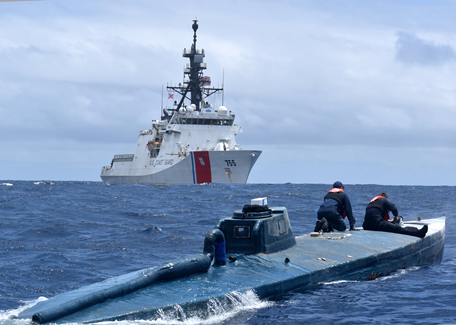SWJ El Centro Book Review – Narco Submarines: Covert Shores Recognition Guide
Robert J. Bunker

H. I. Sutton, Narco Submarines: Covert Shores Recognition Guide. Independent Publisher: San Bernardino, CA: April 2020 [ISBN: 9798624149588, Softcover, 111 Pages]
Narco submarines originating out of Colombia to principally move cocaine up northwards towards the American market have been in existence since at least 1993 with the capture of the ‘San Andrés’ snorkel-sub (p. 30). They have ventured down many evolutionary pathways with dozens upon dozens of them interdicted over almost three decades of time. While some narco submarines are true submersibles, others are built as low-profile vessels or even towed or self-propelled underwater torpedoes that are very difficult to detect upon or in the ocean waters and coastal seas. Increasing numbers of narco submarines have appeared in the last few years, and in an important milestone, the first ever narco sub sailing from Colombia was captured off the coast of Spain in November 2019 on its way to the UK market with three tons of cocaine on board. Narco Submarines, for the first time, seeks to bring some necessary typological order to the appearance of these vessels by creating a practical recognition guide concerning them.
The author of this work, H. I. Sutton, is a well known defense analyst and writer, with subject matter expertise related to underwater warfare including submarines, naval special forces and mini-subs, improvised underwater vehicles, torpedoes, naval history, and of course narco submarines. He runs his own website—Covert Shores, is active on Twitter (@CovertShores) with 18.4K followers, has written for Jane’s Intelligence Review, Forbes, and other related publications, and is frequently interviewed by the press. His earlier self-published booklets include Covert Shores: The Story of Naval Special Forces Missions and Minisubs (2016) and World Submarines: Covert Shores Recognition Guide (2017) with C. Edward Davies.
The marketing advertisement for this new publication states “Narco Submarines provides a go-to guide to the low-profile vessels used to smuggle narcotics in Latin America and across the Atlantic. Based on 10 years of research of over 180 reported incidents (1990s-present), this book presents a practical quick reference guide. It includes a detailed taxonomy, type overviews, cutaways, recognition images, photos and profiles.”[1]
The booklet is divided into loose sections or themes. The term ‘loose’ is used because no formal table of contents exists in the work. The guide breakdown is as follows:
• Going low-pro: narco submarines; 8 page introductory essay
• Taxonomy; 3 pages divided into boats (4 types), torpedoes (4 types), & narco-submarines (5 types with a physical disguise suffix)
• Boats; 3 pages
• Torpedoes; 4 pages
• Narco-submarines; 8 pages
• Early Narco-subs 1990-2005; 8 pages
• Fully Submersible Vessels FSV (Fully-submersible Vessels) 2005 to date; 8 pages
• LPV (Low Profile Vessels) Recognition; 65 pages
• Get Updates; 1 page
• About the Author/Other books by H I Sutton; 1 page
Following the initial essay, typological entries consist of some text paragraphs with either a color rendering of the vessel, black and white profiles with a man figure for scale, and/or color photos of that specific vessel type. These entries are coded in some cases with lettering and number designations or the name of the craft if the incident identified was an early interdiction. While the information is well conveyed to the reader, it does not follow a consistent pattern of presentation with the boats and torpedoes section of the guide representative of older material with just the color renderings. The more extensive LPV (Low Profile Vessels) section, on the other hand, is representative of newer material within the work and includes color renderings, black and white profiles, and also at times color photos. This suggests that the project may have suffered from a lack of resources dedicated to it or that its author simply wanted to get something out now and will update the work in a later version. In total, dozens of renderings, profiles, and photos exist within the guide.

U.S. Coast Guard Cutter Munro (WMSL-755) crew members inspect a self-propelled semi-submersible on June 19, 2019, in international waters of the Eastern Pacific Ocean. US Coast Guard Photo [For Public Release]
https://news.usni.org/2019/07/11/uscgc-munro-returns-from-patrol-with-record-cocaine-haul
The positive aspects of the guide are that it does indeed represent the first recognition guide published on the subject of narco submarines. As an added bonus, it draws upon a well-developed taxonomy of these vessels that has been evolving over some time. Mention of an alternate taxonomy utilized by the Colombian military is also touched upon (pp. 11-13). The work is of high quality printing with excellent photos originally released by the Colombian and U.S. Navies and the U.S. Coast Guard and colorized and black and white computerized drawings of the various types of vessels (including cut outs) that have been encountered. The work is well priced at $19.95 (the list price) though it appears to be discounted online for $15.87.
The other possible drawback to the guide is that the data and imagery are almost wholly non-sourced to reference material—although whether you see this as an actual weakness in the work may depend on your training versus education bias towards its utility. For example, one image tied to an incident states “30-Aug-19, Tumaco, Jungle capture (Pacific)” tied to a Colombian Navy seizure concerning the LPV-OM-10 (Low Profile Vessel, Outboard Motor, Type 10) example (p. 94) but provides no references to the primary or secondary material it is derived from. From a training perspective, reliance on this resource for such basic information may be deemed acceptable given Sutton’s recognized SME status. For those more concerned with provenience of information, however, this results in the guide being the output of a ‘black box’ of referenced incidents (i.e. a data set collected by the author that cannot be readily accessed for further study or validation purposes). Hence, one must take Sutton’s expertise and analysis at face value because it is impossible to easily verify his incident set for any possible mistakes in his analysis.
Additionally, while the booklet is derived from 10 years of Sutton’s own research dating to about 2010, it does not exist in a vacuum of analysis and publication related to narco submarine, although exceedingly limited beyond data points regarding narco sub seizures. Thus, while Sutton did much of the early work on this subject matter posted in a series of blog entries on his Covert Shores website (which included one of the initial typologies on this subject) and should be lauded for this effort, it now co-exists with an edited work by Byron Ramirez and Robert J. Bunker and a later authored work by Javier Guerrero C.
The edited work, Narco-Submarines: Specially Fabricated Vessels Used for Drug Smuggling Purposes, was published online in February 2015 by the U.S. Army’s Foreign Military Studies Office (FMSO), Fort Leavenworth, KS. It was edited by a doctoral student and an adjunct professor (with ongoing U.S. Army linkages) then affiliated with the Claremont Graduate University. This free 164 page booklet (in digital form only) is composed of front and back material, five essays with analysis, a picture gallery and the locations of thirty-three vessels provided, appendices, and references. It represents a collaborative effort involving a number contributions including by then Capt. Mark F. Morris, USN—U.S. Embassy Bogota as the Chief of the U.S. Naval Mission to Colombia—and retired Admiral James G. Stavridis, USN—former Commander of U.S. Southern Command. The drawback to the work is it is older and the dataset provided is much smaller than the one drawn upon by H.I. Sutton with 180 incidents although the later appears to be proprietary for it was not released in the Covert Shores Recognition Guide. The edited work also does not have as sophisticated a vessel typology now utilized by Sutton five years later and was meant as more of an initial textual and visual incident dataset with supporting material also provided.
The second work, Narcosubmarines: Outlaw Innovation and Maritime Interdiction in the War on Drugs, authored by Guerro C. was published in 2020 by Palgrave MacMillan. This short 113 page pocket book is almost all text based and derived from the main findings of his doctoral dissertation while a student at the University of Edinburgh—although Dr. Guerrero C. is a Colombian national and conducted field studies within his home country on the captured examples of these vessels. The focus of the work explores the binary interdiction/evasion dynamic evident between narcotraffickers utilizing narco submarines and the Colombian Navy primarily utilizing patrol boats. The drawback to this work is that it is over-priced at almost $60.00 and has more a academic science and technology studies approach related to innovation that gives it less utility for professional operators.
Within this context, Sutton’s Covert Shores Recognition Guide, thus fills a critical void related to specialized works on narco submarines. The work, even given its at times disjoined structure, will be readily snapped up by the Navies and Coast Guards in the Americas (and now in Western Europe) tasked with interdicting these drug smuggling vessels. Nothing else like it presently exists which makes it a very unique contribution to the study of these craft.
Still, the need for more work and analysis readily exists on these unconventional smuggling vessels. One line of inquiry that should be undertaken would be based on Sutton’s 180 incident proprietary dataset with each entry geographically and time mapped by its taxonomy type. This may provide us with a better understanding of the development and emergence of these vessels over time. Additionally, an evolutionary tree approach—showing the evolution of these vessels from one iteration to the next—would provide another more advanced analysis. The intent would be to ultimately project future vessel iterations in an attempt to get ahead of their evolution so that our policy response, doctrine, and better technical countermeasures could be fruitfully developed.
Note
[1] H. I. Sutton, “Covert Shores Guide – updated: Narco submarines.” Narco Subs 101. 29 March 2020, http://www.hisutton.com/Narco%20Subs%20101.html.
About the Author(s)
Comments
We are committed to…
We are committed to providing our clients with exceptional solutions while offering web design and development services, graphic design services, organic SEO services, social media services, digital marketing services, server management services and Graphic Design Company in USA.

